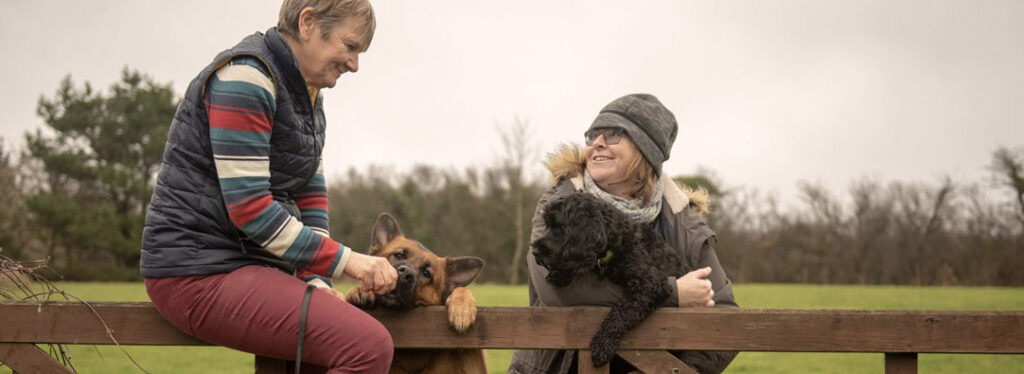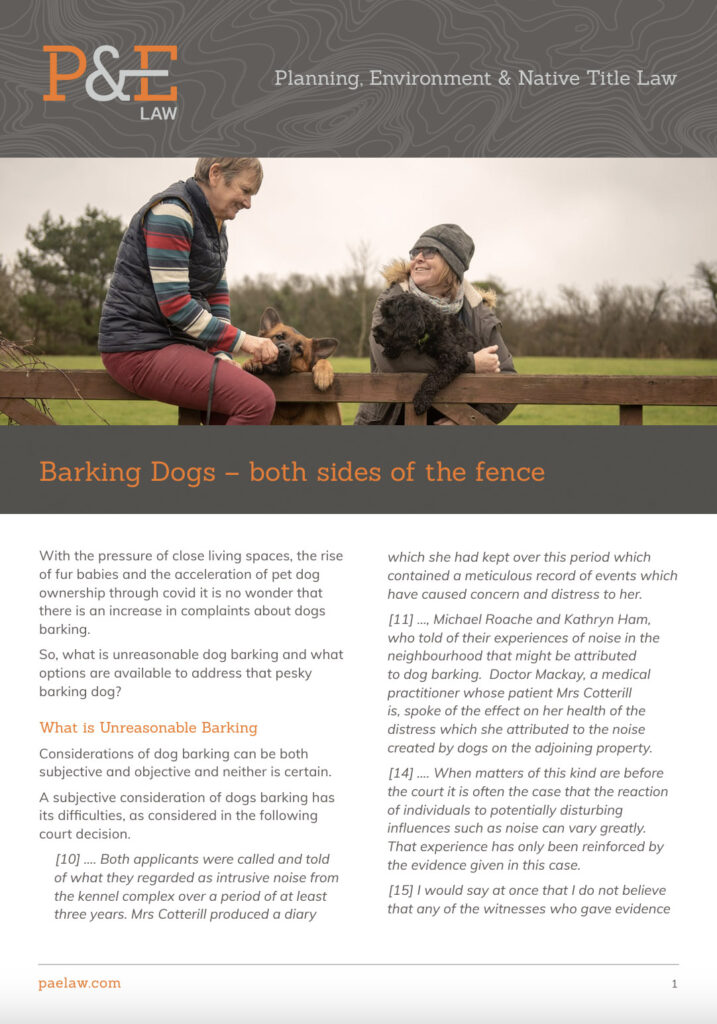
Barking Dogs – both sides of the fence
The noise impacts from a barking dog can be a real nuisance to a neighbour.
But on the other hand, if you are a dog owner, your dog may be wrongly accused of making an unreasonable amount of noise.
This article outlines opportunities to resolve these issues. [May 2023]
With the pressure of close living spaces, the rise of fur babies and the acceleration of pet dog ownership through covid it is no wonder that there is an increase in complaints about dogs barking.
So, what is unreasonable dog barking and what options are available to address that pesky barking dog?
What is Unreasonable Barking
Considerations of dog barking can be both subjective and objective and neither is certain.
A subjective consideration of dogs barking has its difficulties, as considered in the following court decision.
[10] …. Both applicants were called and told of what they regarded as intrusive noise from the kennel complex over a period of at least three years. Mrs Cotterill produced a diary which she had kept over this period which contained a meticulous record of events which have caused concern and distress to her.
[11] …, Michael Roache and Kathryn Ham, who told of their experiences of noise in the neighbourhood that might be attributed to dog barking. Doctor Mackay, a medical practitioner whose patient Mrs Cotterill is, spoke of the effect on her health of the distress which she attributed to the noise created by dogs on the adjoining property.
[14] …. When matters of this kind are before the court it is often the case that the reaction of individuals to potentially disturbing influences such as noise can vary greatly. That experience has only been reinforced by the evidence given in this case.
[15] I would say at once that I do not believe that any of the witnesses who gave evidence sought to mislead the court. What they heard and how they reacted to that depended largely on their disposition and particular sensitivity or aversion to the sound of barking dogs.
[16] Some criticism was levelled at Mrs Cotterill and it was suggested that she had allowed herself to become obsessed with the difficulties which she attributed to the kennel complex. However I believe she deserves a little more sympathy than that. It is not unusual for one to focus on matters that have become a source of distress. One often reacts in a way disproportionate to that in which a less concerned person might. …1
An objective consideration of dogs barking has its difficulties.
The Planning and Environment Court receives expert evidence in relation to noise impacts on a regular basis. Following actual noise logging at a house near to a proposed dog kennel accepted by two experts the experienced judge noted the following:
The different methodologies adopted by Mr McNeilage and Mr Chessells to provide evidence on the critical issue of noise presents the Court with real difficulty in reaching any f inal conclusions. In his report, Mr McNeilage adopts a maximum of 100 dB(A) for one dog and 105 dB(A) for multiple dogs barking which he bases on his experience and the 1995 Guideline (see para 69 of Exhibit 2A). In his oral evidence, he referred to an earlier occasion when he had measured a sound power level of a red setter barking at 103 dB(A). Mr Chessells calculated sound power levels (by reference to Australian Standard 1217-1985, Acoustics – Determination of Sound Power Levels of Noise Sources) from the average maximum sound pressure levels measured of one dog barking which resulted in a starting figure (for his modelling exercise) of 112.9 dB(A) (see Table 6 in Appendix D to Exhibit 6). Mr McNeilage, in Exhibit 2A, used a starting f igure (for one dog) of 100 dB(A) before applying his predicted attenuations.2
The different methodologies led to meaningful differences in the conclusion of the experts as to the reasonableness or otherwise of the noise of dogs barking.
Where evidence of both a subjective and objective nature is given the Court will consider all of that evidence and may prefer some evidence over other evidence.
A considerable body of evidence, both aff idavit and oral, was adduced on behalf of the parties. Some of this evidence was technical, in fact highly technical, being concerned with measurements by instrument of the degree of noise said to emanate from the defendants’ land. I do not propose to deal with the evidence in any detail for two reasons. Firstly, at the conclusion of the evidence, and the addresses by counsel, I had reached a fairly clear opinion as to what my decision should be, but in deference to the time involved in the case and the expense to which the respective parties have been put I decided to reserve my decision. Secondly, I had the advantage of evidence coming from what I regard as reliable and unbiased persons as to the noise or absence of it emanating from the defendants’ premises from dogs kept there, and from the mechanical lure and the engine which activates it. However, I think the parties are entitled to know what facts I have found to be established by the evidence, so that my decision and the reasons for it may be ascertained and critically examined.3
There is clearly a difficulty to determine whether any particular dog barking noise is unreasonable or not.
Talk to Your Neighbour
With good neighbours a sensible conversation between neighbours should allow steps to be undertaken to address the concerns. With isolation in our communities there is less discussion over the back fence and mostly the fences are so high that is impracticable.
Go and politely knock on the front door.
Your neighbour may be surprised that the dog was barking and disturbing you. Often dogs bark when their family is away.
Be calm and explain the impact on you and ask your neighbour if something can be done about it.
There are lots of options available to help and a local vet could provide information about those options.
Neighbourhood Mediation Services
The State government recognises that disputes between neighbours can be resolved with assistance from competent mediators and provides that service through different centres throughout the State.
If you are not able to talk through a resolution with your neighbour, then consider approaching the mediation service.
The web site provides:
“Mediation involves you attending a meeting with your neighbour and one or two mediators.
The mediators act as an impartial third party to guide you through a structured mediation process. They help you decide what you want to achieve and keep the discussion on track, ensuring everyone is heard.
The solution is one that you and your neighbour agree on. It is not imposed on you by anyone else.
When you reach an agreement, the mediators write it down and read it back to you, so you’re both clear about what you’ve agreed.
Mediation for neighbourhood disputes is free and completely confidential.”
Court Action for Nuisance – Live and Let Live
Unfortunately, some of these matters end up before Court. Court actions have been commenced for the tort of nuisance by one neighbour against another neighbour.
Judges prudently recognise the need for tolerance.
“Life in an organised society and especially in populous communities involves an unavoidable clash of individual interests… It is an obvious truth that each individual in a community must put up with a certain amount of annoyance, inconvenience and interference, and must take a certain amount of risk in order that all may get on together. The very existence of organised society depends on the principle of ‘give and take, live and let live’… Liability is imposed only in those cases where the harm or risk to one is greater than he ought to be required to bear under the circumstances.” 4
They also recognise that there are two sides to most of the situations brought before the Court.
“…whether the neighbour is using his property reasonably, having regard to the fact that he has a neighbour. The neighbour who is complaining must remember, too, that the other man can use his property in a reasonable way and there must be a measure of give and take, live and let live.” 5
If you do consider that the conduct of your neighbour’s barking dog is outside of the bounds of what is reasonable then you may wish to speak with your local solicitor.
Your solicitor will consider your prospects and advise you what evidence is required if you wish to proceed.
These actions are costly to run and will only inflame the dispute in the neighbourhood.
Council Local Laws
All Councils have local laws and subordinate local laws that address animal management, including barking dogs.
If a complaint is made to a Council, it will ask you to provide evidence.
That would typically include:
- the preparation of a logbook over time recording the incidents of the barking describing the frequency and hours at which that occurs; and
- statements by all the adults living in the premises that are affected by the barking.
The people who give the statements would need to be available to give evidence before a Court.
You may also be asked to identify others in the neighbourhood who are also affected by the dog barking who would also be willing to give evidence in Court.
You may also engage the assistance of a noise expert to prepare a report.
Councils have to proceed on evidence and without that are constrained in what they can do.
The Council will need to analyse that evidence just as the Court did in Mole, Dean and Wecker, the cases referred to above, and then determine what, if any, steps should be undertaken.
One Council we know had about 100 complaints of dogs barking in six months when only one complainant was willing to take the steps to provide suitable evidence.
If you cannot provide evidence that shows the noise barking falls outside the realm of what is reasonable the Council cannot assist.
If you do provide evidence that satisfies the Council, it has the capacity to take steps to try to alleviate the barking dog noise.
If that is challenged the Council would need to make a decision as to whether to proceed or not.
That will usually include a consideration of who is willing to be cross examined in Court.
Conclusion
The best outcome in relation to barking dogs is an amicable discussion with your neighbour.
If not, please consider whether the state mediation service can assist you.
The Council will need to be satisfied on evidence before it takes any action and that will require a commitment from you to produce material.
You can also instruct a solicitor to consider your prospects in an action for nuisance which also requires evidence but is a matter over which you have control.
REFERENCES
1 Cotterill & Anor v Young & Anor [2000] QPE 011
2 Reservilt Pty Ltd v. Maroochy Shire Council [2002] QPEC 010 para [36]
3 Mole, Dean and Wecker v B & B Swift Supreme Court No 820 of 1978
4 Hill v Higgins [2012] NSWSC 270.
5 Kennaway v Thompson [1981] QB 88 (CA) at 94
